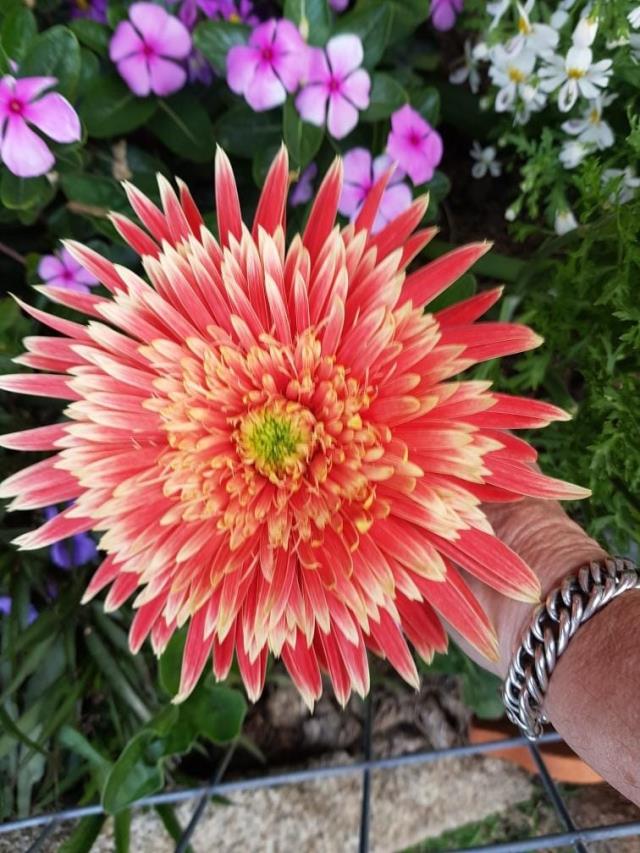By Beatrice Hawkins
As a small child a lady who lived down the road and was known as “Granny Hayes”, grew Gerberas down each side of her front path. I loved the look of them and aspired to growing them but have never really had the right situation so have never tried.
I was at a friend’s place recently and she showed me her garden. There, front and centre, was the beautiful specimen you see in the photo. It is almost dinner plate size and just beautiful – a far cry from the old varieties Granny Hayes grew!
Gerberas originate in South Africa and the hybrids available today are almost unrecognisable as the humble Transvaal daisy.
A lot of the work in developing these beautiful specimens had occurred in Western Australia as the climate is very suited to them. They like a warm climate and well drained soil so the west is ideally suited to them. Full sun is a must, as is good drainage, but having said that, they don’t like to dry out, so regular watering is a must as is mulch to help keep the moisture in.
The original colours were a dull red and yellow but the variety these days is huge with vibrant red, yellow, orange, crimson, white and pink. Then, of course, we have the many bi colours that put on a great show.
If you don’t have good drainage you can always build the beds up or grow them in pots in good potting mix.
They can be raised from seed harvested from spent flower heads in spring and summer and it is then best sown immediately. This is an interesting experiment as they often do not reproduce true to type and it is fun to see what you have when they eventually flower. The other method is by simply dividing the clumps in October or November. They will need to be well watered when transplanted.
So many plants that thrive in our climate are from Africa and another that is providing amazing colour at the moment is the common South African daisy or osteospermum. It seems to thrive on neglect and produce quantities of daisy flowers in a range of colours from white through pink and all shades to deep purple.
They are providing a great display in many gardens around town at the moment and open up as soon as the sun is there. They self seed readily and come up each year to provide a show of colour in the early spring. I don’t have any growing but intend to see that I do by next year. They self seed so readily that they can become invasive but are easily removed to keep them under control.
As with Gerberas, African daisies now come in an amazing array of colours and forms, brown, burgundy and yellow, and doubles or with fluted petals. Gardening magazines will delight you with beautiful photos as will a walk through your favourite nursery to see what is available.
To keep them blooming, regular dead heading is a good idea, as is pruning by about one third to keep them in shape. They grow from 30 to 60 centimetres high and up to a metre wide in the right situation and by pinching out the growing stem when they are small you will create a sturdier plant with a good dense form. Once they start to produce buds, discontinue this practice as it will retard flowering.
I love all the English and European annuals and perennials that we have traditionally grown in Australian gardens but applaud the increase in popularity of these easy to grow, dry tolerant, African imports.
Some lovely effects are achieved with a combination of both.
Old fashioned gaillardias, Indian blanket flower, are another favourite. They are a short lived perennial and native to dry areas of North America right down to Mexico. There are over two dozen species of the gallardia genus and of course these days they have been hybridised and bred to fill many spots in the garden with brilliant colour.
I am looking forward to seeing photos of the displays in the many parks in Toowoomba during the coming weeks of the festival. I have read that there have been over 170,000 seedlings planted to provide a spectacular display in all the beautiful parks. The theme is “Family Time” in the Laurel Bank Park and is a “must see” if you are going to Toowoomba.
Once again a reminder that the annual Warwick Spring Flower Show has, unfortunately, been cancelled but the Garden Competition and Floral Window Display will still be held with schedules available at Bryson’s Place in Palmerin Street.
This year, with so many things cancelled because of health restrictions, let’s make the floral Window Competition a truly spectacular event. Get behind your business, club or school, find a window to decorate and show the locals and visitors how creative you are!
*This is an old article that has been digitised so our readers have access to our full catalogue.







